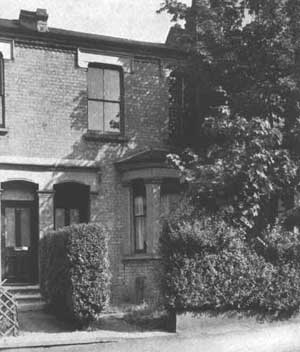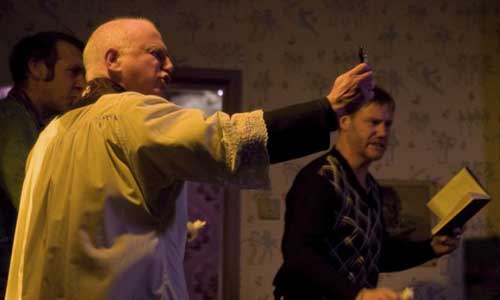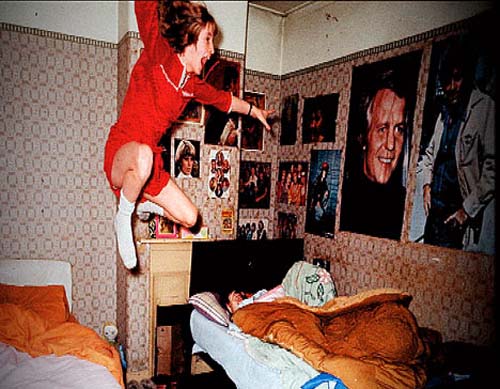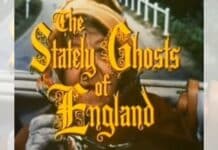With the Enfield Haunting, starring Timothy Spall as Maurice Gross, coming soon to Sky Living TV, GIANNA DE SALVO thought it was a fitting time to review that particular case, as well as some other well-known British poltergeist accounts.
The Battersea Poltergeists: Eland Road (1928)
Battersea, at the time of both of these famous cases, was a run of the mill working class neighbourhood.
It did, however, seem, for a little while anyway, to be a poltergeist hotspot.In 1928, following reports in the press, Harry Price decided to investigate for himself the allegations of poltergeist-like activity that seemed to be occurring in Eland Road in the late 1920’s.
The property was a typical one, in which lived a Mr. Robinson, his 27 year old son Frederick and Frederick’s three daughters, one of whom had a fourteen your old son. At the back of the house was a small conservatory that seemed to be the focus of the initial activity. On the 29th November 1928, a number of objects, most notably lumps of coal and pennies, seemed to appear from nowhere and then bombard the glass of the conservatory, shattering several of the windows. What seemed to be interesting here is that the projectiles did not seem big enough to break the glass and that upon further inspection by a member of the police force, the direction from which these objects were originating could not be deduced. Another interesting feature was the presence of a building behind the house which was reported to be a private asylum or home for men suffering from shell shock. Whether the objects were thrown from this location or not could not be determined.

However, the activity began to spread to other parts of the house, with a stand in the hall being overturned and a chest of drawers in Mr. Robinson senior’s room falling over. So frightened was Mr. Robinson senior that he was removed from the home for the duration of the alleged activity. Afterwards, according to one of the daughters, the chairs seemed to march in single file around the house and when she tried to lay the Sunday table, the chairs stacked themselves upon the table so that it was impossible to do so. Other phenomena presented itself, which led Price to conclude “on the three occasions when I witnessed the movements of the objects I could never be quite certain that a normal explanation could not be found for the supposed phenomena…it must be admitted that the problem presents some very unusual features…[which] mark the Battersea mystery as being decidedly out of the ordinary run of such cases. I feel convinced.” Harry Price has written about the Eland road case in his book Poltergeist Over England (Country Life, 1945).
Wycliffe Road (1950-60s)
A further supposed haunting in Battersea was reported over twenty years later and is undoubtedly a very unusual case. According to Shirley Hitchings, the focus of the apparent poltergeist phenomena, it all began with a key. Upon entering her bedroom at No 63 Wycliffe Road on the afternoon of January 1956, Shirley, then aged 15, noticed a strange silver key on her bed. When she inquired about the origin of this key with her parents, they neither knew where it came from nor what door it fitted. Following that, Shirley and her family began to witness objects moving that would then reappear in various locations and hearing strange raps and knocks on the walls. Some of the knocks seemed to respond to questions from the family and, therefore, have intelligence. After an exorcism attracted police attention, attention from the press soon followed. Interested to see whether there was any truth to what was represented in the papers, Harold Chibbet, a paranormal investigator and author, asked the family’s permission to more closely investigate their claims.
What followed was a detailed account of an ‘entity’ that could not only communicate via knocks and raps, but who could also write letters and draw pictures. He was supposedly even able to send out Christmas cards and could steal jewelry out of shop windows. He also insisted on being kept sweet and asked for specific gifts and for the family to adhere to certain rules, lest he get angry and set fires in the home, which he was apparently wont to do. And if that sounds phenomenal, the entity, whom Shirley initially named “Donald,” also claimed to be a prince: the short-lived Louis XVII or Louis-Charles. This seemed to explain why several of “Donald’s” letters seemed to have been written in a combination of French and English.
While much of the questioning of Donald and his history left several gaps and inconsistencies, Harold Chibbet seemed convinced that something remarkable happened for over a decade at No 63 Wycliffe Road. Even the late Andrew Green heard knocks that he could not explain, although he didn’t seem as convinced as Chibbet that “Donald” wasn’t just a manifestation of Shirley’s unconscious mind. According to Hitchings, although the phenomena died down about a decade after it started, she was questioned not that long ago by a woman who claimed to be a sensitive about who the little blond boy in period costume was, who seemed to follow her around.
Shirley Hitchings and James Clark’s book is entitled The Poltergeist Prince of London (The History Press, 2013).
The Pontefract Poltergeist (1966)
The most violent poltergeist case in Europe on record is known as The Pontefract Poltergeist, later referred to as The Black Monk of Pontefract. The activity allegedly began at N.30 East Drive in East Yorkshire during a bank holiday weekend in August 1966. On that date, Jean and Joe Pritchard, and their daughter Diane aged 12, left Philip, aged 15, at home with his grandmother, Sarah, as they went on holiday.
It all started with Sarah feeling a cold gust of wind in the house, followed shortly by a strange white powder that seemed to materialse in mid air in the living room and fall to the floor. Later, Sarah’s daughter, a neighbour and a man from the Water Board all witnessed mysterious pools of water appearing in the kitchen that seemed to originate from an unexplainable source. After that, several bangs were heard throughout the house, along with the clattering of items in the kitchen. Additionally, a plant that was normally secure in a pot at the bottom of stairs was found without its pot on the middle of the steps. After Mr. and Mrs. Pritchard returned from holiday, the activity seemed to cease, only to start up again two years later.

Strange phenomenon was becoming so common in the house, that the family began referring to the entity as “Fred.” The focus of the poltergeist seemed to be on the daughter Diane who was often thrown from her bed and was once pulled up the stairs by unseen hands around her neck. Eventually, the entity materialised itself in the form of what witnessed described as a monk-like figure, without a face. The case, from that point forward, began to be referred to as the Black Monk of Pontefract. Shortly after the monk appeared, however, the haunting seemed to cease as quickly as it started.
After the 2012 release of the film, When the Lights Went Out, which documented some of the phenomena that occurred in the house, there are reports that the strange occurrences have started up again. There are even reports that the initial screening of the film at the Price Charles Cinema in London’s Leicester Square was fraught with problems, including the power continually going out in the screening room only while the rest of the cinema seemed to be unaffected. Were the events at No. 30 East Drive a hoax or real? According to investigator Colin Wilson, given the number of witnesses and the vast amount of recorded, unexplained occurrences, there certainly seemed to be something unexplainable by normal means happening in Pontefract.
When the Lights Went Out is a 2012 film by director Pat Holder. Colin Wilson has also written about the case in his book: Poltergeist! A Study in Destructive Haunting (NEL, New English Library, 1981).
The Enfield Poltergeist (1977-1978)
The Enfield case is still regarded as the most documented and fascinating case of poltergeist phenomena in British history. Much of that is due to the meticulous care that the two investigators, Maurice Gross and Guy Lyon Playfair of the Society of Psychical Research, took in attempting to record each and every strange occurrence that took place in the otherwise nondescript council house in Enfield, England in the late 1970’s. In fact, they recorded over 2,000 types of phenomena over the several months they spent examining the case.
The focus of the commotion, during which time knocking was heard in the walls, furniture appeared to move of its own accord and objects appeared to materialize within the house and elsewhere, was eleven year old Janet. The phenomena were so focused on Janet that over time it was claimed the entity, identified as a resident who had died in the property called “Bill,” began speaking through her in a deep guttural voice. The voice would speak even when Janet’s mouth was filled with water and taped up. It was theorised that she could be utilising “false” vocal chords to make the sounds, but it was also acknowledged that this would cause much soreness in the throat after a short period of time; an ailment which Janet did not admit to suffering from even after “Bill” spoke at great length through her. Although Janet and her sister were caught in the act of trickery at a couple of points in the investigation, Guy Lionel Playfair, as well as about dozen witnesses at the time, still attest to the fact that something very unusual and unexplainable was happening on that quiet,suburban street not so long ago.
Guy Lyon Playfair’s book This House is Haunted (White Crow Books; 3rd edition edition (20 April 2011) describes in detail the events that occurred in Enfield. (You can read an article “Mystery Still Surrounds Enfield Poltergeist” written by Guy Lyon Playfair especially for Spooky Isles here.)










